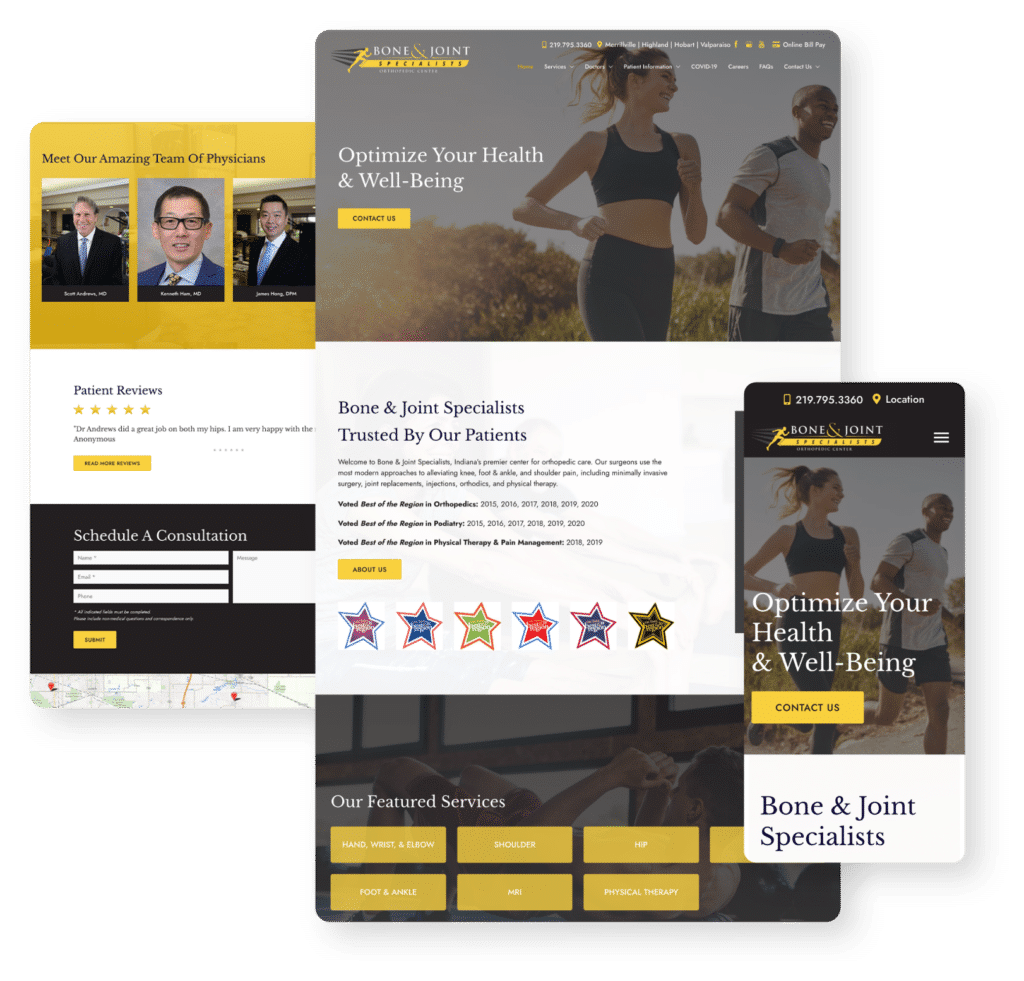
Unlocking the Potential of Orthopedic Website Design: 5 Essential Keys
We often equate an appealing website with a good one, but what truly defines an outstanding orthopedic website? Delving into the intricacies of web design in the medical field, here are five indispensable secrets to crafting an exceptional orthopedic website.
The 5 Key Features of an Exceptional Orthopedic Website
1 |
User-Friendly Navigation
Providing an exceptional user experience is not a luxury; it's a fundamental requirement.
Picture your website as a smoothly functioning, well-oiled joint in the human body. In the rush to create a perfect digital representation, it's easy to underestimate the navigational challenges newcomers might face on your website. For them, locating the exact information they seek can be as challenging as hunting for a needle in a haystack. Providing an exceptional user experience is not a luxury; it's a fundamental requirement. This includes a well-structured navigation bar that guides users effortlessly, an efficient search function that acts as a compass through your digital landscape, a logically organized layout of information that eliminates confusion, and readily accessible contact information, allowing your visitors to reach out effortlessly. These elements collectively streamline the journey for your visitors, leaving them with a positive impression of your orthopedic website.
2 |
Compelling, Relevant Content: Engaging Your Audience
Attracting prospective patients to your website is just the beginning of the journey. The real challenge is retaining their interest. People visit your website with specific intentions, be it seeking information about orthopedic procedures or identifying a new orthopedic surgeon nearby. If they can't easily locate what they're searching for or, worse, if they find your content uninspiring, their digital visit will likely end prematurely. Investing time and effort into creating high-quality, relevant content is a worthwhile endeavor that benefits not only your users but also your search engine rankings. This investment pays dividends in the form of engaged visitors who linger on your website, exploring its offerings and potentially transforming into loyal patients.

3 |
Cross-Browser and Cross-Device Compatibility: A Responsive Approach
In the realm of web design, the gold standard is responsive design.
While aesthetic considerations, like color schemes and font choices, play a role in design, responsiveness transcends mere visual appeal. Responsive design is the practice of ensuring that your website displays correctly across a diverse array of devices and browsers. Neglecting this aspect is equivalent to turning away potential patients. In fact, a significant 42% of users will abandon a website if it fails to function properly (TopDesignFirms, 2021). Be it a cutting-edge iPhone running Google Chrome or a Google Pixel with Firefox, your website should adapt seamlessly. Disregarding responsive design leads to user frustration, causing the loss of nearly half of your website's visitors.
4 |
Accessibility Compliance: Ensuring Inclusivity and Avoiding Penalties
Here's an often-overlooked fact: the Americans with Disabilities Act (ADA) has established standards that websites are expected to meet. Failing to adhere to these standards can have serious repercussions for your practice. Non-compliance not only renders your website unusable for the nearly 1.4 billion people with disabilities worldwide but also exposes you to penalties from search engines. The ADA compliance guidelines outline that a violation could result in penalties ranging from $55,000 to $75,000 for the first offense, with subsequent violations escalating to a $150,000 fine. Ensuring accessibility isn't just a legal requirement; it's a moral imperative and a practical necessity that guarantees inclusivity and avoids legal and financial consequences.
5 |
Streamlined Visitor-to-Patient Conversion: Elevating Success Metrics
Your website's performance centers around a pivotal metric: the conversion rate.
This metric quantifies the rate at which website visitors transition into becoming patients. If your orthopedic website doesn't achieve a conversion rate of at least 3%, it's an indication that a reevaluation of your approach is in order. This entails a close examination of your conversion elements, such as buttons, forms, chat widgets, or other points of contact, and, if necessary, a comprehensive website redesign to enhance the transition from visitor to patient. A streamlined conversion process is essential for the sustained growth of your orthopedic practice.
Excelling in the competitive orthopedic field means you have to seamlessly integrate captivating design, accessibility, robust security measures, and, notably, a high conversion rate on your website. These elements form the foundation of your website's success, ensuring that it not only attracts but effectively converts visitors into valued patients.
If you need help upgrading your orthopedic website, consider enlisting the guidance of digital marketing experts who can navigate this journey with you. Contact one of our MyAdvice professionals for a complimentary consultation today.
Curious how your website stacks up against your competition?
We built a tool for that. Enter your website address and we’ll send you a custom report.

